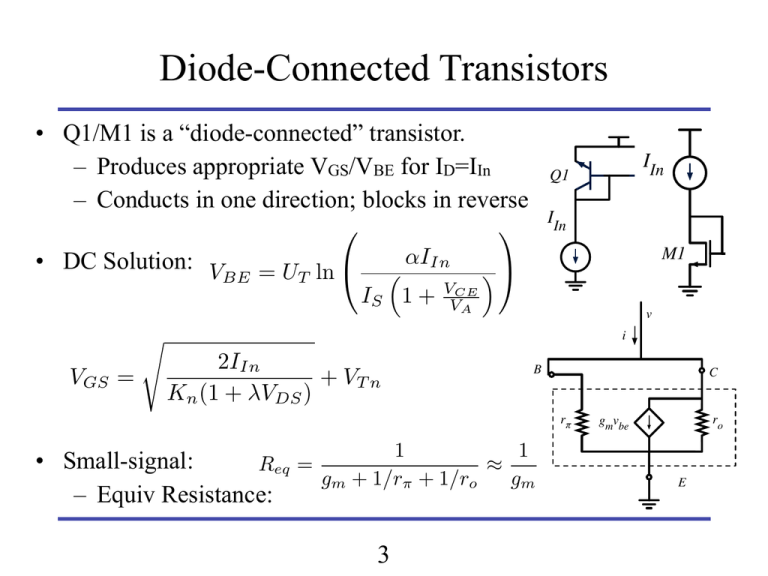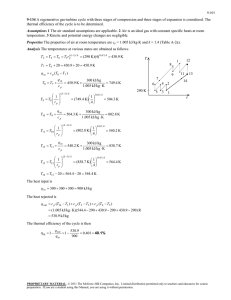Diode Transistors & Current Mirrors Analysis
advertisement

Diode-Connected Transistors
• Q1/M1 is a “diode-connected” transistor.
– Produces appropriate VGS/VBE for ID=IIn
– Conducts in one direction; blocks in reverse
⇤
IOut
M1
VOut
v
i
B
C
rπ
1
1
• Small-signal:
Req =
⇡
gm + 1/r⇡ + 1/ro
gm
– Equiv Resistance:
3
Q2
IIn
⌅
IIn
• DC Solution:
V = U ln ⇧
⇥⌃
BE
T
IS 1 + VVCE
A
2IIn
VGS =
+ VT n
K
(1
+
V
)
n
DS
IIn
Q1
ro
gmvbe
E
Current Mirrors
• M1 is a “diode-connected” transistor.
– Produces appropriate VGS for ID=IIn
IIn
– Active mode guaranteed for enhancement
device
M1
• Applies same VGS to M2
• IOut = ID2 = IIn = ID1
– Assuming M1 and M2 identical and in
active mode
Q1
– Neglecting channel-length modulation
IIn
– w/ BJT mirror, IIn ≠ IC1
• IOut =?
4
IOut
M2
Q2
IOut
VOut
Current Mirrors - Applications
• Copy/distribute a bias or signal current
• Change direction of a current - convert
between current source and sink
• Isolate current source from load impedance
– (RIn ~ 1/gm) << (ROut ~ ro)
IIn
IOut
M2
M1
Q1
Q2
IOut
IIn
VOut
5
MOS Current Mirrors: DC Analysis
1+ λV
(
DS2 ) ≅ I
∴I = I
REF
O REF
1+
λ
V
( DS1)
MOSFETs M1 and M2 are
assumed to have identical VTN,
Kn’, λ, and W/L ratios.
However, VDS1 is not equal to VDS2 and
there is slight mismatch between
output and reference currents. Mirror
ratio is:
€
IREF provides operating bias to
mirror.
1+ λV
(
DS2 )
MR = O =
I
REF (1+ λVDS1)
I
VDS1 = VGS1= VGS2 =VGS
6€
MOS Current Mirror (Example)
Problem:Calculate output current for given current mirror.
Given data: IREF = 150 µA, VSS = 10 V, VTN = 1 V, Kn = 250 µA/V2, λ =
0.0133 V-1
Analysis: (1+ λ VDS1) term is neglected to simplify dc bias calculation.
V
=V
=V +
DS1 GS1 TN
2I
REF =1V + 2(150µA) = 2.10V
Kn
µA
250
V2
#
&
0.0133
%1+
(10V)((
%
$
'
V
∴I = (150µA) #
=165µA
&
O
0.0133
%1+
(2.10V)((
%
$
'
V
€
€
Actual currents are found to be mismatched by
approximately 10%.
7
MOS Current Mirrors: Changing Mirror
Ratio
1+ λV
(
DS2 )
∴I = I
O REF
K (1+ λV
n1
DS1)
W
1+ λV
(
DS2 )
L
2
=I
REF W
1+ λV
(
DS1)
L 1
W
1+ λV
(
DS2 )
L
2
MR =
W
1+ λV
(
DS1)
L 1
K
Mirror ratio can be changed by
modifying W/L ratios of the two
transistors forming the mirror.
- Or w/ multiple FETs in parallel
$
&
&
%
$
&
&
%
"
$
$
#
"
$
$
#
€
'
)
)
(
'
)
)
(
%
'
'
&
%
'
'
&
n2
In given current mirror, Io =5IREF. Again
mismatch in VDS causes error in MR.
€
8
Bipolar Current Mirrors: DC Analysis
BJTs Q1 and Q2 are assumed to
have identical IS, VA, βFO, and
W/L ratios.
Io = IC2,
IB2
IREF = IC1 + IB1 +
VBE1= VBE2 =VBE
!I
O
=I
"
$1+(V
#
CE2
%
/V )'
A &
REF "$ V
2
$1+ CE1 +
$$
V A ! FO
#
%
'
'
''
&
Even w/ equal VC1, VC2, finite β causes
slight mismatch between Io and IREF.
9
Bipolar Current Mirrors: Changing Mirror
Ratio
Emitter area scaling changes the
transport equations using which,
(1+(VCE2 /VA ))
I = nI
REF # V
O
1+n &
CE2
%1+ V + β (
$
A
FO '
Ideally, MR= n, but for finite beta,
€
Mirror ratio can be changed by
modifying the emitter area of the
transistor.
10
Multiple Current Sources
•
•
•
•
11
Reference current enters diode-connected
transistor M1 establishing gate-source
voltage to bias M2 through M5, each with
different W/L ratio.
Absence of current gain defect permits
large number of MOSFETs to be driven by
one reference transistor.
Similar multiple bipolar sources can be
built from one reference BJT.
As base current error term worsens when
more BJTs are added, number of outputs of
basic bipolar mirror are limited.
Buffered Bipolar Current Mirror
Assuming infinite Early voltage for simplicity,
Large mirror ratio leads to large
current gain defect
Q3 provides base currents, reduces
error
Thus error term in denominator is
reduced.
12
Output Resistance of Current Mirrors
This simplifies the ac model of
the current mirror. Similar
analysis applies to MOSFET
current mirror except that the
current gain is infinite. Thus
For diode connected BJT, from smallsignal model,
...If βoand µF >>1
13
or
Current Mirror with Resistor
Degeneration
• How to size resistors for
scaled mirrors?
• Degenerate both sides to
maintain equal VGS
• Resistor scales inversely
with transistor W/L
– Equal voltage drop
across RS
IIn
IOut
1 W
k L
kRS
14
W
L
RS
Reference Current Generation
•
•
Reference current is required by all current mirrors.
When resistor is used, source’s output current is directly
proportional to VEE.
•
Gate-source voltages of MOSFETs can be large and several
MOS devices can be connected in series between supplies to
eliminate large resistors.
VDD + VSS = VSG4+ VGS3 + VGS1 and ID3 = ID1 = I4
•
Change in supply directly alters gate-source voltage of
MOSFETs and the reference current.
BJTs can’t similarly be connected in series due to small fixed
voltage developed across each diode and exponential
relationship between voltage and current.
•
15
Current Mirror Biasing Example
• NMOS Mirror KN = 250uA/V2, Vtn = 0.6.
ID = 25uA. VDD = 10V
– Ignore ro for bias calculation
RBias
16
IOut
Current Mirror Biasing Example
• NMOS Mirror KN = 250uA/V2, Vtn = 0.6.
ID = 25uA, VDD = 10V
– Ignore ro for bias calculation
• VGS = VTn + sqrt(2ID/Kn) = VDD - IDRB
= 1.04 V
• IDRB = 8.95. RB = 358k
17
RBias
IOut
Differential Amplifier
• Differential pair provides
two output currents
• Often want single-ended
output - need to combine the
two currents into one.
• Opposite polarities - can’t
simply wire together.
18
iod/2
-iod/2
Differential Amplifier with Active Load Quick Look
• Current mirror reverses polarity of one output current so
the two can be combined
• Current-mirror load increases output resistance and gain
• Converts differential output current to single-ended
Adm = isc Rth = gm2 (ro2 ||ro4 ) ⇡ µf 2 /2
Ro = ro2 ||ro4
Acm
⇣
ro3
ro2
⌘
1+
isc Rth
=
=
(ro2 ||ro4 )
vic
2µf 3 Rss
✓
◆
(ro2 + ro3 )
ro4
1
=
=
2gm3 ro3 Rss ro2 + ro4
2gm3 Rss
19
If ro4 = ro3
CMOS Differential Amplifier with
Active Load: DC Analysis
ID3 = ID1 = ID2 =ID4 =ISS/2.
Mirror ratio is set by M3 and M4 and is exactly
unity when VSD4 = VSD3 and thus VSD1 = VSD2.
Differential amplifier is completely balanced at
dc when:
20
CMOS Differential Amplifier with Active Load:
Differential-Mode Signal Analysis
The differential amplifier can be
represented by its Norton equivalent.
Total short circuit output current:
Differential-mode voltage gain:
Thevenin equivalent output resistance:
21
High output resistance, well-modeled as
transconductor (VCCS). “Operational
Transconductance Amplifier” (OTA)
CMOS Differential Amplifier with
Active Load: Output Resistance
Drain current of M2 (vx/2ro2)is replicated by
current mirror as drain current of M4. Total
current from source is 2(vx/2ro2)= vx/ro2.
Total current is:
Output resistance
Assume RSS >>1/ gm1.
is:
Resistance looking into drain of
✓ M2 (in isolation)
◆ is:
1
Ro2 = ro2 (1 + gm2 RS ) = ro2 1 + gm2
= 2ro2
gm1
But current mirror doubles id2
22
CMOS Differential Amplifier with Active
Load: Common-Mode Signal Analysis
From small-signal equivalent of differential pair:
Roc = ro2 (1 + gm2 2RSS )
#
%
%
%
%
$
2µf 2 RSS
&
r (
1+ o3 (( #
#
&
r ( % v &(
g
o2 ' % ic (
isc = −%%ioc + g v − o2 v (( ≅ −
%
(
%
m4 3 2 3 ('
µ
% 2R
(
$
f 3 $ SS '
where it is assumed that gm4 = gm3 and Goc << gm3.
€
Acm
⇣
ro3
ro2
⌘
1+
isc Rth
=
=
(ro2 ||ro4 )
vic
2µf 3 Rss
✓
◆
(ro2 + ro3 )
ro4
1
=
=
2gm3 ro3 Rss ro2 + ro4
2gm3 Rss
If ro4 = ro3
23



